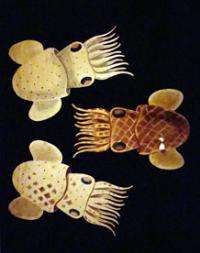Exeter biologist rediscovers 'forgotten' 19th century illustrations

A unique collection of nineteenth century visual teaching aids belonging to the University of Exeter has been rediscovered after more than six decades.
The slides were created by local naturalist Charles Thomas Hudson FRS to illustrate his lectures.
They are framed paintings of microscopic animals and plants, all masked with thick brown paper. When backlit in a darkened room the transparencies are transformed, beautifully illuminating the various organisms.
They have seen little use, apart from the occasional open day, and have been kept in a dark room in the University’s Hatherly Laboratories since the 1960s. These storage conditions have proved ideal and the collection is still in excellent condition.
The collection has now been given a new lease of life thanks to retired University of Exeter zoologist Dr. Robin Wootton, whose cataloguing project has brought the slides out of obscurity. He painstakingly photographed each individual painting, using Photoshop Elements to optimise lighting and visibility.
Dr. Wootton, Chairman of the Devonshire Association, has also been instrumental in uncovering the history of the transparencies. His research was aided by a sheet of typescript which revealed that the University had acquired them from a Mrs F.R. Rowley on the death of her husband, the curator of Exeter’s Royal Albert Memorial Museum, in the late 1930s.
How Rowley came to own the transparencies is still unknown, although it is possible that he may have known Hudson personally. Both were members of the Royal Microscopical Society¬ - Hudson was its President from 1888-9 - and there may have been a local connection between Rowley, who lived in Exeter and Hudson, a Dawlish resident.
Dr. Robin Wootton said: “We knew the transparencies were interesting historically, but nothing prepared me for their sheer beauty when backlit and displayed as they were intended to be. Their impact to Victorian audiences must have been dramatic indeed.”
Head of Biosciences at the University of Exeter, Professor Rick Titball said: “Robin has done a fantastic service is publicising this stunning University collection. The slides perfectly illustrate the complexity and beauty of these life forms, and are even more astonishing when you consider they are unique. We are delighted that his hard work has enabled them to be enjoyed by people all over the world.”
The entire collection can be viewed here. The history of the transparencies has been published in the 2011 Transactions of the Devonshire Association Volume 143.
The Devonshire Association is currently celebrating its 150th anniversary with a program of special open events throughout the year.
Provided by University of Exeter





















